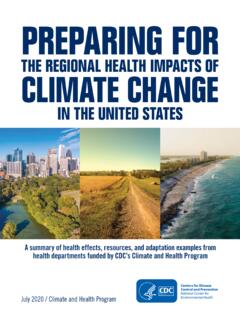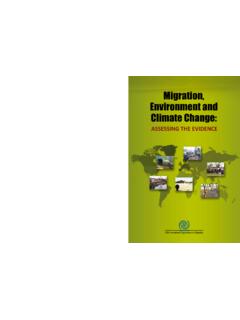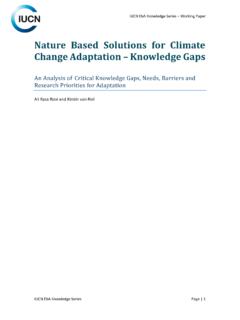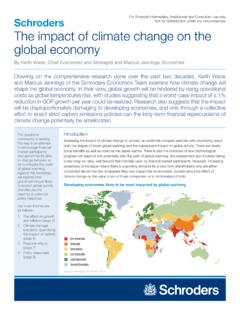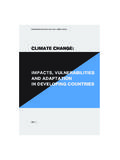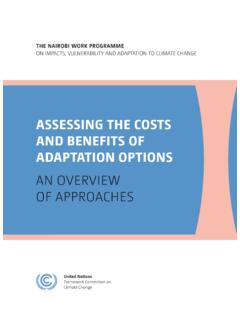Transcription of Assessing Health Vulnerability to Climate Change
1 Assessing Health Vulnerability to Climate Change A Guide for Health Departments Climate and Health Technical Report Series Climate and Health Program, centers for disease control and prevention Arie Ponce Manangan1, Christopher K. Uejio2, Shubhayu Saha1, Paul J. Schramm1, Gino D. Marinucci1, Claudia Langford Brown1, Jeremy J. Hess1,3,4, George Luber1. Climate and Health Program, Division of Environmental Hazards and Health Effects (DEHHE), National center for 1. Environmental Health (NCEH), centers for disease control and prevention (CDC) Atlanta, GA, USA. 2. Department of Geography, Florida State University, Tallahassee, FL, USA. 3. Department of Emergency Medicine, School of Medicine, Emory University, Atlanta, GA, USA. 4. Department of Environmental Health , Rollins School of Public Health , Emory University, Atlanta, GA, USA.
2 National center for Environmental Health Division of Environmental Hazards and Health Effects CS249409-A. Executive Summary: The changing Climate is linked to increases in a wide range of non-communicable and infectious diseases1. There are complex ways in which climatic factors (like temperature, humidity, precipitation, extreme weather events, and sea-level rise) can directly or indirectly affect the prevalence of disease . Identification of communities and places vulnerable to these changes can help Health departments assess and prevent associated adverse Health impacts. The Climate and Health Program at the centers for disease control and prevention (CDC) has developed the Building Resilience Against Climate Effects (BRACE) framework to help Health departments prepare for and respond to Climate change2.
3 The BRACE framework is a five-step process that helps Health departments to understand how Climate has and will affect human Health , and enables Health departments to employ a systematic, evidence-based process to customize their response to local circumstances. The first step of the BRACE framework focuses on anticipating Climate impacts and Assessing associated Health vulnerabilities. This document provides a suggested sequence of steps that Health departments can undertake to assess such Health vulnerabilities associated with Climate Change : 1) Determine the scope of the Climate Vulnerability assessment a. Identify the area of interest and the projected Change in Climate exposures at the smallest possible spatial scale. b. Identify the Health outcome(s) associated with these Climate exposures.
4 2) For these Health outcomes, identify the known risk factors ( , socioeconomic factors, environmental factors, infrastructure, pre-existing Health conditions). 3) Acquire information on Health outcomes and associated risk factors at the smallest possible administrative unit ( , census block group, census tract, county) in accordance with data privacy regulations and availability. 4) Assess adaptive capacity in terms of the system's ( , communities, institutions, public services) ability to reduce hazardous exposure and cope with the Health consequences resulting from the exposure. 1. 5) Combine this information in a Geographic Information System (GIS) to identify communities and places that are vulnerable to disease or injury linked to the Climate - related exposure.
5 The value of a Vulnerability assessment is that it allows Health departments to understand the people and places in their jurisdiction that are more susceptible to adverse Health impacts associated with the Climate -related exposures modified by Climate Change . This assessment of people and place Vulnerability can then be used to implement more targeted public Health action to reduce harm to people. **. 2. Introduction This document provides guidance for Health departments on how to assess local vulnerabilities to Health hazards associated with Climate Change . A Climate and Health Vulnerability assessment allows Health departments to understand the people and places in their jurisdiction that are more susceptible to adverse Health impacts associated with Climate Change .
6 This assessment of people and place Vulnerability can then be used to implement targeted public Health interventions to reduce the burden of public Health impacts. This document provides a conceptual framework on how to define Vulnerability to Climate Change , using terms and definitions found in the Health and Climate Change scientific literature. Specifically, we define the term exposure as referring to Climate -related exposures such as extreme heat or precipitation. We also provide an example of how to conduct a Climate and Health Vulnerability assessment using a case study on heat Vulnerability in Georgia. Although there are myriad Climate factors that impact Health ( , storm surge, increased atmospheric CO2, extreme precipitation events, drought, etc.)
7 , heat Vulnerability was selected as a case study because it was identified as the most important Climate -sensitive Health outcome of concern in a survey of the eighteen grantees of the CDC's Climate -Ready States and Cities Initiative. In addition, there is a wealth of research and available data on the topic of heat Vulnerability . Health Vulnerability from Climate Change The combination of projected changes in Climate -related exposures ( , temperature, precipitation, sea-level rise) reported in the National Climate Assessment (NCA)3 will result in amplification of existing Health risks and introduction of new risks with a high degree of spatial variability. The Climate and Health Program at the centers for disease control and prevention (CDC) has developed the Building Resilience against Climate Effects (BRACE) framework to help Health departments prepare and respond to these Change (Figure 1).
8 The BRACE framework incorporates an assessment of Climate Change impacts, a Vulnerability assessment, the modeling of projected Health impacts, an evidence-based evaluation of intervention options, a strategy for implementing interventions, and systematic evaluation of all activities in an iterative framework. 3. Figure 1. Building Resilience Against Climate Effects (BRACE) framework The Vulnerability assessment is critical in various stages as an agency works through the BRACE. framework (i) in step one, it guides Health agencies to assess specific communities and places that are vulnerable to projected Climate impacts; (ii) in step three provides knowledge on which specific public Health interventions to implement in order to reduce the Health burden; and (iii) in step four provides community characteristics ( , socioeconomic, environmental, infrastructural) in the development and implementation of a Climate and Health adaptation plan.
9 What is a Climate and Health Vulnerability assessment? A useful definition of Vulnerability ' in the public Health context is the the degree to which a system is susceptible to injury, damage, or harm 4. This broad definition emphasizes the importance of well-functioning institutions and the accessibility to quality healthcare that safeguards individual and population health5,6. Although there are multiple interpretations of the terms Vulnerability , risk, and sensitivity in the global Change literature7,8, for this report we define Vulnerability as being a function of exposure, sensitivity, and adaptive capacity9-11. This definition of Vulnerability is consistent with the Third National Climate Assessment (2014): Vulnerability is a function of the character, magnitude, and rate of Climate variations to which a 4.
10 System is exposed, its sensitivity, and its adaptive capacity 12. The following diagram (Figure 2). illustrates the key connections between exposure, sensitivity, and adaptive capacity that collectively determine Vulnerability to the Health system resulting from Climate Change . Figure 2. Vulnerability determined by exposure, sensitivity, and adaptive capacity (Source: Australian Greenhouse Office, 2005). A Climate Vulnerability assessment identifies where Health susceptibilities exist due to Climate Change , which will continue to alter the magnitude, frequency, duration, and geographic extent of various Climate -related exposures that are detrimental to human health3. Sensitivity encompasses (1) the ability of a community to withstand these exposures and the range of associated impacts; and (2) physiological ( , co-morbidities or disabilities) and socio- economic ( , poverty) factors that increases the susceptibility of individuals to the exposure.










